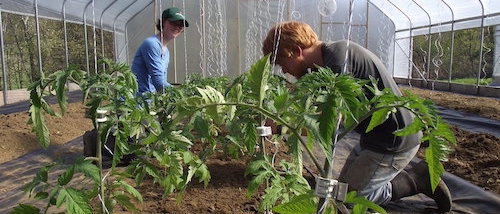A practical approach to intercropping
When we started A Way of Life Farm in 2009, intercropping and companion planting (the practice of growing two or more crops in the same space at the same time) were a part of how we wanted to farm. Yet, after some trial and error, we abandoned it, writing it off as “not practical on a farming scale.” However, we revisited it a few years later as we were looking for ways to maximize space in our new high tunnel. Now, it has become a very important part of how we continue to grow more and more food on the same (or even less) area over the last few years.
“Why even bother?” you might ask. Intercropping helps protect the soil from sun, wind, and rain by increasing the amount of vegetative cover. More plants also mean more photosynthesis which will mean more carbon being pumped into the soil, feeding a greater diversity of soil microbes — especially if we plant different species of plants in the same space.
Aside from these benefits to soil health, we have noticed improved crop growth in certain crops when they are intercropped versus being grown alone. Radishes are one crop that I wish I never have to grow by themselves again. They produce so much better when intercropped, and then when they are finished, I don’t have to worry about what to do with that empty short section of bed while the other crops finish maturing. The main crop simply takes over and uses the whole bed space.
Even without improved crop growth, we find that we are able to increase value per bed-foot. For a crop like broccoli that might be marginally profitable alone, adding $2 of value to each foot of a bed by intercropping might make the difference in that bed space being profitable or not.
The challenge is to maximize these benefits without causing problems for any of the crops occupying the space. Poor timing, spacing, or just mismatched crops can end up causing disease, stunting, and decreased harvest efficiency.
On our farm, we approach intercropping using what we call “squeeze crops,” which are generally smaller, faster crops (radishes, baby greens, salad turnips, etc.) paired with larger, longer-season crops that are planted in one or two rows per bed (tomatoes, broccoli, or cabbage, for example).
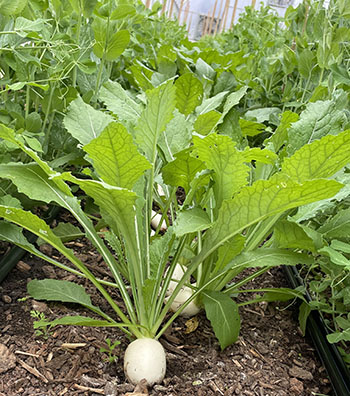 Ground-level view of salad turnips planted between two towering rows of snap peas.
Ground-level view of salad turnips planted between two towering rows of snap peas.
We plant one row of squeeze crop between two rows of main crop, or two rows on either side of a main crop that is planted in one row per bed. With proper attention to crop pairing and timing, we can “squeeze” in an extra harvest before the main crop needs to take over the whole bed space. Good squeeze crops are generally mature and harvested within 50 days from planting, and they are always paired with main crops that mature after 55 to 60 days. Also, our squeeze crops tend to be “light feeders,” having less demand for water and fertility compared to their main crop counterparts. This approach works well on our 32-inch-to-36-inch wide bed tops.
Timing is critical! Always plant squeeze crops on or even before the day of planting the main crop, especially if the squeeze crop is to be direct seeded. In 2022, I got a little lazy about that rule, sometimes coming back two days after transplanting the main crop to seed my squeeze crop. At harvest time, I more often noticed decreased crop quality due to overcrowding, light competition, and poor air flow.
In spring and fall, all our large brassicas, which are planted in two rows at 15 inches to 20 inches apart, depending on the specific crop, are paired with a single row of a squeeze crop down the middle of the bed. Radishes, salad turnips, baby greens, spinach, cilantro, dill, small bok choy and baby head lettuce all fill this context well.
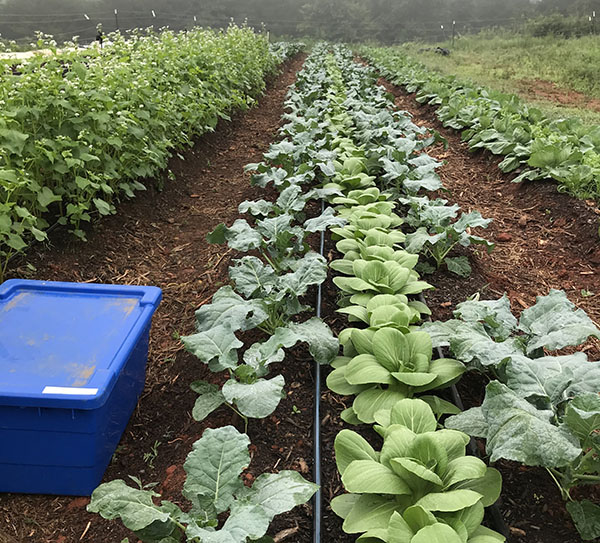 Bok choy intercropped with broccoli. After these bok choy are harvested, the broccoli will continue to grow, filling in the empty space left by the bok choy.
Bok choy intercropped with broccoli. After these bok choy are harvested, the broccoli will continue to grow, filling in the empty space left by the bok choy.
Full-sized head lettuce and escarole are both possibilities, but at 55 to 60 days to harvest, they are more marginal, sometimes yielding a decent crop, while other times ending up too crowded. I don’t like scallions as a middle row squeeze crop, because even if they are transplanted, they take too long to mature and are a little more involved to harvest, compared with head lettuce, for example. At that point the larger main crop is more difficult to work around and more easily damaged.
For warm-season high tunnel crops like tomatoes and cucumbers (actually planted in early March here in North Carolina) grown in a single row down the middle of each bed, we plant a row of squeeze crop down each side of the bed. Generally, we use the same group of squeeze crops here as we plant with our cool season brassicas. However, scallions, large head lettuces, and escarole, which are marginal as a middle row squeeze crops, have greater potential on an outside row where they are less likely to get shaded out by the main crop.
When we first started experimenting with intercropping (the second time around) we planted grafted tomatoes down the middle row of what would normally be five rows of Salanova lettuce in a bed. Thus, two rows of lettuce down each side of the tomatoes. The resulting lettuce crop was beautiful and plentiful, but the tomatoes certainly faltered until the lettuce was harvested and removed. Only then did they recover and begin growing as they should.
This is not how successful intercropping should work. Successful intercropping is when both crops are able to grow to maturity in the same space, concurrently, with little to no sacrifice made by either crop. We had a similar result when I tried planting celery down the sides of a trellised cucumber crop. The celery was amazing, but the cucumbers definitely suffered. Celery is probably a marginal squeeze crop, due to its length to harvest and high demand for water and nutrients. It might make a great main crop, with a squeeze crop down the middle.
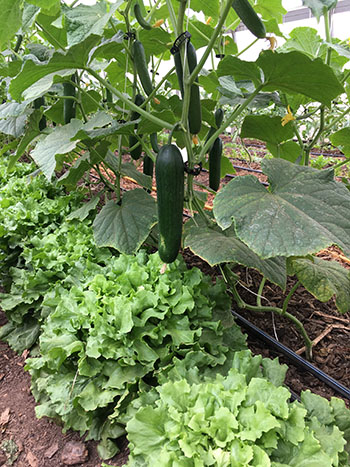 Trellised cucumbers with escarole intercrop ready to be harvested. All images courtesy of the author.
Trellised cucumbers with escarole intercrop ready to be harvested. All images courtesy of the author.
For other high tunnel crops like peppers, ginger, turmeric, sugar snap peas and basil, all of which we grow in two rows per bed, we are able to squeeze in another crop down the middle, before they get shaded out. The high tunnel is a great place to start experimenting with intercropping because it tends to get more attention than field space, and the potential benefits are so great.
We used to have a much more pronounced gap in production through the months of March and April when our high tunnels were already planted in summer crops and our spring field crops had not yet started to produce. It was painful at that time to watch such valuable real estate be monopolized by those wide-spaced tomatoes, cucumbers, and peppers. Now, by intercropping, we are able to plant all that space in between and close the harvest gap between winter greens production and spring field crops.
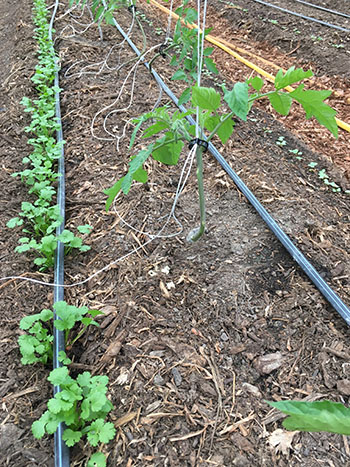
Trellised tomatoes with transplanted cilantro along one side and direct seeded arugula down the other.
In the summer field crops, we tend to intercrop less. Some crops like summer squash, field cucumbers, watermelon, and winter squash do not share very well. They tend to cover their beds so quickly that the squeeze crops I have discussed so far would get overwhelmed. Also, we cover these cucurbits at transplanting time with row cover as pest prevention, making the space under there even more inhospitable to our squeeze crops which are generally considered cool season crops.
Bush beans, however, are one crop we do try to intercrop in the summer, though it tends to be more challenging than the cool season main crops. Direct seeded in two rows per bed, bush beans have out-competed and smothered any of the squeeze crops we have mentioned so far. Transplanting sweet corn down the middle of the two bean rows was an interesting experiment for a couple years.
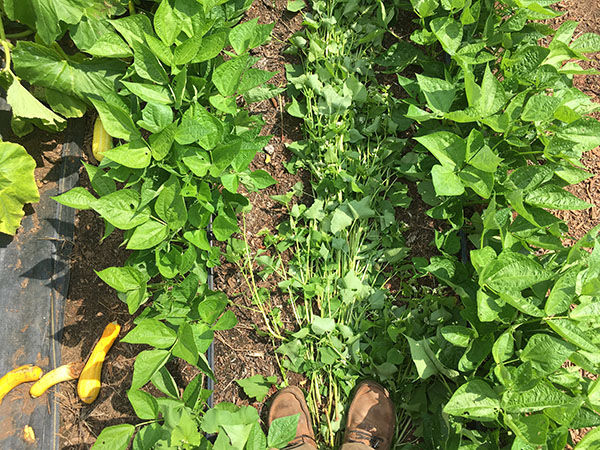 Overhead view of two rows of bush beans. The buckwheat intercrop has just been trampled and left to remain in the bed as mulch.
Overhead view of two rows of bush beans. The buckwheat intercrop has just been trampled and left to remain in the bed as mulch.
While we don’t see sweet corn as a profitable crop on a market farming scale, we do like to eat it, so we are always looking for ways we can squeeze in a little sweet corn somewhere without sacrificing production space. Intercropping seemed like the perfect solution. We found that by transplanting, the corn was able to grow above the height of the beans before it got shaded out. We hoped that the tight spacing of 6 inches would help with pollination, since planting only a single row is not ideal for plants like corn that are wind pollinated.
The first year, while pollination was far from perfect, we were able to harvest enough sweet corn to satisfy ourselves, and the beans didn’t seem to mind sharing the bed space. The huge increase in biomass added to the bed by the corn when we mowed those crops down was a great bonus. The next year, we used the same strategy, only in a different field where the beds and rows happen to be aligned parallel to prevailing winds (instead of perpendicularly as in the previous year). With that one change, the result was near perfect pollination, more corn than we needed to eat, and suffering beans with shriveling pods, having been out-competed by the corn for the available water.
So, while it seemed like a good idea, and I do like to eat corn, it didn’t seem worth potentially hurting the crop we were actually growing for market. Our compromise with the bush beans has been to seed a row of buckwheat down the middle. Buckwheat is less dominating than corn and quicker to maturity. We usually leave it to flower for a bit and then trample it and chop it with a shovel, leaving the buckwheat residue as a mulch for the remaining bean crop. While we aren’t adding any direct economic benefits by intercropping with buckwheat, we do get the added benefits to soil health.
Certain squeeze crops, like baby greens and herbs like dill and cilantro, will need to be terminated and removed (or possibly left as mulch) after their final harvest, otherwise they will continue growing and create space competition for the main crop. I like to leave a few plants of cilantro or arugula to flower every 20 feet or so to attract predatory insects. Yet, leaving the entire row was a mistake, resulting in a whole row of flowering cilantro flopping onto the heading broccoli, and causing them to rot.
When growing arugula, lettuce mix, or any other baby greens as a squeeze crop, it is worth noting that you give up the possibility using any sort of greens harvester. We used to use the Quick-cut Greens Harvester for baby greens, but it is too wide to fit between the outer two rows. In our context, this has been a reasonable compromise. Also, there is no guarantee of a second cut from baby greens when grown between two rows of main crop.
As long as I am not absolutely planning on needing a second harvest, I see this as acceptable. There was no extra bed preparation needed for planting this crop, I get the benefits to soil health, and I get a good harvest of a high-value crop without any added fertilizer or without needing to cultivate more land. I might need to seed a little more frequently, but in our context, we see this as well worth it.
While I would probably not recommend intercropping for the beginning grower, a little experience with the life cycles and habits of a handful of plants, and good awareness of your farm’s context, gives a good framework to start experimenting and see what works for you.
Jamie Davis runs A Way of Life Farm with his wife, Sara Jane, in the foothills of western North Carolina, where, with the help of their crew, they grow Real Organic Certified produce and raise pastured pigs.
